Histopathological Spectrum of Gastroduodenal Biopsies in North East India - A 1 Year Cross-sectional Study in a Tertiary Care Centre
Download
Abstract
Background: Gastrointestinal problems are very common nowadays and most people are likely to experience gastrointestinal symptoms throughout their lives. Acid peptic disease (APD), including gastric ulcers, duodenal ulcers, and gastro esophageal reflux disease is a common disorder of the gastrointestinal region, the pathogenesis of which involves an imbalance between acid secretion and gastric mucosal defenses. Besides, malignancies are also fairly common in these regions. This is a study done in 100 cases of gastroduodenal biopsies in a 1 year period.
Aims and Objectives: To see the histopathological spectrum of gastro-duodenal biopsy tissue collected by endoscopy and to correlate the association with clinical and demographic findings.
Result: The prevalence of gastroduodenal lesion is more common among males around the fifth decade of life. Abdominal pain and dyspepsia were the most common presenting clinical complaint. There were 56 benign cases, 11 cases of premalignant category (Dysplasia/ Metaplasia) and 27 malignant cases, out of which Moderately differentiated Adenocarcinoma was the most common.
Conclusion: Endoscopic gastroduodenal biopsies helps in detecting benign as well as malignant lesions. A variety of non-neoplastic and neoplastic lesions were reported in the present study across a wide range of age and site distribution. The combination of endoscopy and histopathological study of gastroduodenal biopsy provide a powerful diagnostic tool for better management of patients.
Introduction
Diseases of upper gastrointestinal tract are responsible for a great deal of morbidity and mortality. The inflammatory and neoplastic lesions are particularly common among them [1]. The most common abnormalities which are frequently reported by endoscopy are duodenal ulcer (2.3-12.7%), gastric ulcer (1.6-8.2%) and gastric malignancy (0-3.4%) [2]. The most common condition affecting the gastrointestinal tract is Acid Peptic Disease [3]. The upper gastrointestinal flexible fibroptic endoscope was first used in 1968 and proved to be a major breakthrough in the diagnosis of gastro duodenal lesions [4]. Gastrointestinal endoscopy is considered accurate for the diagnosis of acid peptic diseases. It allows the physician to visualize and biopsy the upper gastrointestinal tract including the esophagus, stomach and duodenum [5]. Apart from diagnostic utility, endoscopic biopsies are also used to monitor the course of the disease, extent of the disease, to detect complications and to assess the response to therapy. Hence, these are considered one of the useful methods for investigation of gastro intestinal lesions [6]. The histopathological study of endoscopic biopsies permits exact diagnosis for further management. It can detect the early stages of the neoplastic lesions and may prevent the progression of these lesions to invasive cancer [1].
Aim of the Study
The aim of this study is to find out the histopathological spectrum of endoscopic gastroduodenal biopsy and to correlate the association of gastro-duodenal pathology with clinical and demographic findings.
Materials and Methods
This is a hospital based cross sectional study which has been carried out in the Department of Pathology in collaboration with the department of Gastroenterology for a period of 1 year from July 2020 to June 2021. A total of 100 patients with chronic upper abdominal symptoms are selected for the study. The tissue is processed, sections are made of 3 micrometre thickness and then stained with Haematoxylin and Eosin stain.
Exclusion Criteria
Cases where biopsy cannot be done, or where consent not given and autolysed specimen were excluded.
Ethical Issue
The study has been ethically approved by the Institutional ethical committee (letter no- 190/2007/ dt-11/dec-2019/61). The patients were explained about the research project and written consent was taken from patients or guardians in case of minors.
Results
A total number of 100 patients who underwent gastroduodenal biopsies and fulfilled the inclusion criteria as per stated were enrolled during the study. The age of the patients varied from 25 to 84 years with peak incidence in the 5th decade. The male: female, M: F ratio is 1.85:1. Depending upon the symptoms and clinical presentation, gastric biopsies were taken from 59 cases and duodenal biopsies from 41 cases (Table 1).
| Site of biopsy | No of cases | Percentage |
| Gastric biopsies | 59 | 59 |
| Duodenal biopsies | 41 | 41 |
Abdominal pain was the most common clinical complaint (Table 2).
| Presenting complaints | No of cases | Percentage |
| Dyspepsia | 32 | 32 |
| Pain abdomen | 48 | 48 |
| Vomiting | 25 | 25 |
| Nausea | 25 | 25 |
| Loss of weight | 27 | 27 |
| Loss of appetite | 33 | 33 |
| Epigastric pain | 11 | 11 |
| Heart burn | 10 | 10 |
| Belching | 7 | 7 |
| Hematemesis | 7 | 7 |
| Jaundice | 2 | 2 |
Out of the 100 gastroduodenal biopsy studied, 56% were diagnosed as benign, 11% as premalignant condition and 27% as carcinoma (Table 3).
| Categories | Type of lesion | No of cases | Total cases | Percentage (N=100) |
| N=100 | ||||
| Normal | Normal findings | 6 | 6 | 6 |
| Benign | Gastritis | 26 | 56 | 56 |
| Duodenitis | 21 | |||
| Polyp | 3 | |||
| Celiac Disease | 6 | |||
| Premalignant | Gastric Intestinal Metaplasia | 2 | 11 | 11 |
| Low Grade Dysplasia | 8 | |||
| High Grade Dysplasia | 1 | |||
| Malignant | Carcinoma Stomach | 23 | 27 | 27 |
| Carcinoma Duodenum | 4 |
In the present study, benign category had the highest number of cases, maximum of which belonged to the age group of 41-50 years. Among the benign category maximum numbers of cases (46%) were diagnosed as gastritis (Figure 1 to 7).
Figure 1. Hyperplastic Polyp Showing Elongated, Cystically Dilated Foveolar Epithelium.
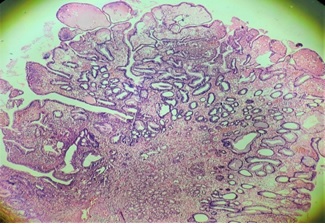
Figure 2. Celiac Disease Showing Blunted Villi, Crypt Hyperplasia and Intraepithelial Lymphocytosis.
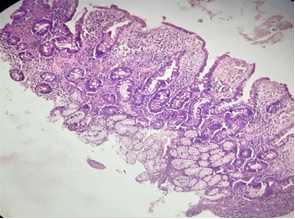
Figure 3. Fundic Gland Polyp Showing Cystically Dilated Glands Lined by Parietal Cells .
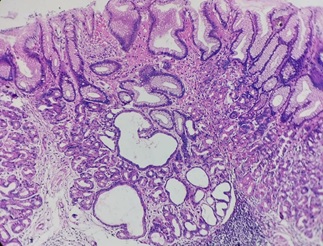
Figure 4. Gastritis Showing Presence of Chronic Inflammatory Cells.
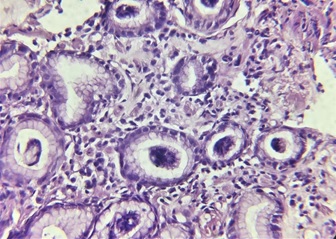
Figure 5. Non Specific Duodenitis.
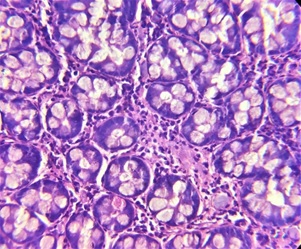
Figure 6. Chronic Duodenitis .
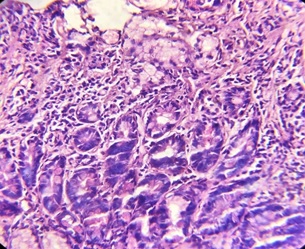
Figure 7. Gastric Ulcer with Granulation Tissue Reaction.
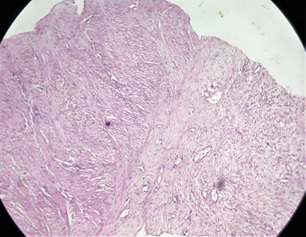
Maximum number of cases from the premalignant category belonged to age group 41-50 years. Maximum number of malignant cases belonged to the age group 51-60 years.
26 cases were diagnosed as gastritis, out of which maximum number of cases (30.8%) belonged to the age group of 51-60 years. 8 cases were diagnosed as premalignant, out of which maximum number of cases (50%) were in the age group of 41-50 years. 23 cases were diagnosed as Gastric Carcinoma, out of which maximum number of cases (34.8%) belonged to the age group of 51-60 years.
21 cases were diagnosed as Duodenitis, out of which maximum cases 62% belonged to the age group of 41-50 years. 6 cases were diagnosed as Celiac Disease. 3 cases diagnosed as premalignant and 4 cases as Duodenal Carcinoma. Maximum cases of duodenal carcinoma (75%) belonged to the age group of 51-60 years.
11 cases diagnosed as premalignant, out of which 73% cases were of low grade dysplasia, 9% cases of high grade dysplasia and 18% cases of metaplasia (Table 4) (Figure 8).
| Sub categories | No of cases (N=11) | Percentage (N=100) |
| Gastric Intestinal Metaplasia | 2 | 18 |
| Low grade dysplasia | 8 | 73 |
| High grade dysplasia | 1 | 9 |
Figure 8. Goblet Cell Metaplasia of Gastric Antrum.
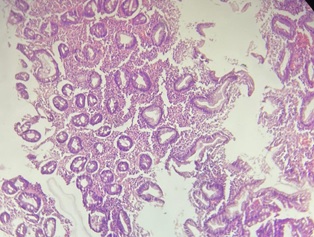
27 cases were diagnosed as carcinoma, out of which 23 cases (85.1%) are Carcinoma Stomach and 4 cases (14.9%) are Carcinoma Duodenum. The age group 51-60 had the maximum number of cases (Table 5) (Figure 9 to 12).
| Age | Carcinoma Stomach | Carcinoma Duodenum |
| 21-30 | 1 | 0 |
| 31-40 | 4 | 0 |
| 41-50 | 4 | 0 |
| 51-60 | 8 | 3 |
| 61-70 | 2 | 1 |
| 71-80 | 3 | 0 |
| 81-90 | 1 | 0 |
| Total (N=27) | 23 | 4 |
Figure 9. Well Differentiated Adenocarcinoma of Stomach.
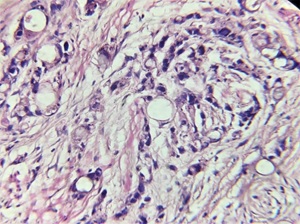
Figure 10. Moderately Differentiated Adenocarcinoma of Stomach.
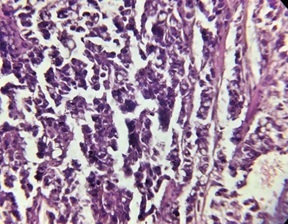
Figure 11. Diffuse Adenocarcinoma with Signet Ring Cells of Stomach.
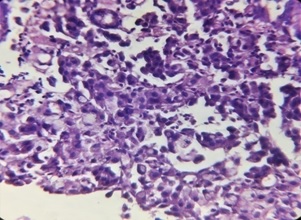
Figure 12. Periampullary Adenocarcinoma of Duodenum .
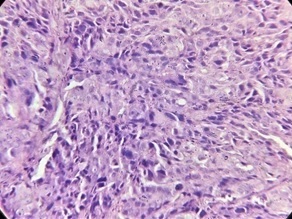
Moderately differentiated adenocarcinoma was the common common histologic type of tumor and Antrum was the most common site involved by tumor (Table 6, 7).
| Types | Cases | Percentage (N=100) |
| Well differentiated adenocarcinoma | 7 | 25.90 |
| Moderately differentiated adenocarcinoma | 9 | 33.35 |
| Poorly differentiated adenocarcinoma | 5 | 18.50 |
| Poorly differentiated adenocarcinoma with signet ring cell morphology | 6 | 22.25 |
| Site | Cases | Percentage (N=100) |
| Body | 7 | 26 |
| Antrum | 14 | 51.80 |
| Pylorus | 2 | 7.40 |
| D1 region | 4 | 14.80 |
| D2 region | 0 | 0 |
| Total (N=27) | 27 |
Discussion
Biopsy sampling of the gastric mucosa during endoscopy provides useful information which helps in the diagnosis of various lesions. The most common indications for gastric biopsy are; to detect various types of gastritis along with evidence of gastric ulcers, different tumors and Helicobacter pylori status.
In the present study, out of the 100 gastroduodenal biopsies, 59 cases were from gastric region and rest 41 cases were from the duodenum. The present study is consistent with the studies made by Shanmugasamy K et al [7], Vijayabasker Mithun KR et al [8], S. Hirachand et al [9], Deepa Rani et al [10] and Veenaa Venkatesh et al [11] which shows that gastric biopsies are more common compared to duodenal biopsies.
In the present study, the number of male patients were 65 and female patients were 35. Male (M) : female (F) ratio is 1.85: 1. The present study is consistent with the studies made by Dr Vishwapriya M. Godkhindi et al [12], Poonam Sharma et al [13] and S. Hirachand et al [9] which shows male preponderance in gastroduodenal lesions.
In the present study, the highest number of cases were in the age group of 41-50 years followed by 51-60 years. The present study is consistent with the studies made by Shanmugasamy K et al [7], Manasa P Kumari et al [14], Vijayabasker Mithun KR et al [8] and Kaur Manpreet et al [15] which show that gastroduodenal lesions are more common in the 5th and 6th decade of life.
In the present study, the most common clinical complaint was pain abdomen followed by dyspepsia. The present study is consistent with the studies done by Dr Vishwapriya M. Godkhindi et al [12], Rosy Khandelia et al [16] and Sharma S et al [17] which show that pain abdomen is the most common presenting symptom but not consistent with Sonam Pruthi S et al [18] and Shanmugasamy K et al [7] which show dyspepsia as the most common presenting symptom. This disparity may be due to food habits, geographic variations or social habits. In the present study, there were 56 non neoplastic cases, 11 premalignant cases and 27 malignant cases. The present study is consistent with the studies done by S. Hirachand et al [9], Kaur Manpreet et al [15], Deepa Rani et al [10] and Sharma S et al [17] which show non neoplastic lesions are more common than neoplastic lesions in the gastroduodenal region.
In the present study, there were 26 cases of gastritis, 21 cases of duodenitis, 3 cases of polyp and 6 cases of celiac disease respectively among the non neoplastic category. The present study is consistent with the studies done by Dr A Sultana et al [19], Kirana Pailoor et al [20], Shanmugasamy K et al [7], Kaur Manpreet et al [15] and Veenaa Venkatesh et al [11] which show that most common non neoplastic lesion in the gastroduodenal region is chronic gastritis.
In the present study, there were total of 27 cases (27%) of malignancy out of which 23 cases (85.1%) are of Carcinoma Stomach and rest 4 cases (14.8%) are of Carcinoma Duodenum. The present study is consistent with the studies done by Kirana Pailoor et al [20] and Shanmugasamy K et al [7] which show that the most common site of neoplastic lesion in the gastroduodenal region is the stomach.
In the present study, there were total of 27 cases of malignancy, out of which maximum number of cases were of Moderately differentiated Adenocarcinoma. The present study is consistent with the studies made by Shanmugasamy K et al [7] and S. Hirachand et al [9] which show that most common type of gastric neoplasm is moderately differentiated adenocarcinoma.
In the present study, the most common duodenal lesion is Duodenitis out of which 12 cases were Non specific duodenitis and rest 9 cases were Chronic duodenitis. The present study is consistent with the studies made by Kirana Pailoor et al [20], Shanmugasamy K et al [7], S. Hirachand et al [9], Kaur Manpreet et al [15] and Veenaa Venkatesh et al [11] which show that Non specific duodenitis is most common among duodenal lesions.
Strength of the Study
Premalignant lesions are found among study population which show that early detection with the help of endoscopy and biopsy will help in prompt intervention and better management of the patient.
Weakness of the Study
The limitation of the present study is the sample size which is very less and done for a very short duration.
The study is a hospital based cross sectional study due to which follow up of the cases were not possible.
In conclusion, Endoscopic gastroduodenal biopsies help in detecting benign as well as malignant lesions and also to rule out H. pylori infection. A variety of non-neoplastic and neoplastic lesions were reported in the present study across a wide range of age and site distribution. The commonest site of upper gastrointestinal lesions was stomach. The prevalence of gastroduodenal lesion is more common among males around the fifth decade of life. Abdominal pain and dyspepsia were the most common presenting clinical complaint. The combination of endoscopy and histopathological study of gastroduodenal biopsy provide a powerful diagnostic tool for better management of patients.
References
- Rupendra Thapa, Mamta Lakhey, Pradeep Kumar Yadav, Prakash Kandel, Choodamani Aryal, Kamana Subba, “Histopathological Study of Endoscopic Biopsies” .
- Role of endoscopy and biopsy in the work up of dyspepsia Tytgat G. N. J.. Gut.2002;50 Suppl 4(Suppl 4). CrossRef
- The histopathological study of gastroduodenal Biopsies and Helicobacter Pylori Infection in acid Peptic Disease Patients Kadam PNR , Chavan YH , Shinde Aparna , Hanmante RD . Journal of Evolution of Medical and Dental Sciences.2013;2(27):4883-4889.
- Endoscopic Interpretation. Normal and pathologic appearances of the Gastrointestinal tract Blackstone MO . New York: Raven Press.1984;:13-15.
- Internet, https://www.hopkinsmedicine.org/gastroenterology_hepatology/_pdfs/esophagus_stomach/peptic_ulcer_disease.pdf .
- A study on histopathologic spectrum of upper gastrointestinal tract endoscopic biopsies. Krishnappa R, Horakerappa MS , Mangala Ali Karar , GouriMangala . Int J Medical Res Health Sciences.2013;2(3):418-424.https://www.nepjol.info/index.php/jbpkihs/article/view/19760/16242.
- “Clinical Correlation of Upper Gastrointestinal Endoscopic Biopsies with Histopathological Findings and To Study the Histopathological Profile of Various Neoplastic and Non-Neoplastic Lesions” Shanmugasamy K, Bhavani K, Anandraj Vaithy K, Narashiman R, Dhananjay S Kotasthane . .
- “Spectrum of Gastroduodenal Lesions in Endoscopic Biopsies: A Histopathological Study with Endoscopic Correlation” Vijayabasker Mithun KR , Rajesh Kumar G, Govindaraj T, Arun Kumar SP . Available online at http://saspublisher.com/sjams/..
- Histopathological spectrum of upper gastrointestinal endoscopic biopsies Hirachand S, Sthapit RR , Gurung P, Pradhanang S, Thapa R, Sedhai M, Regmi S. JBPKIHS.2018;1(1):68-67.
- A study of morphological spectrum of upper gastrointestinal tract lesions by endoscopy and correlation between endoscopic and histopathological findings Rani D, Bhuvan S, Gupta A. Indian Journal of Pathology and Oncology.;6(1). CrossRef
- Histopathological Spectrum of Lesions in Gastrointestinal Endoscopic Biopsies: A Retrospective Study in a Tertiary Care Center in India” Veenaa Venkatesh, , Riyana R Thaj . World Journal of Pathology.;(10).
- The Histopathological Study Of Various Gastro-duodenal Lesions and Their Association with Helicobacter pylori Infection. Godkhindi V. IOSR Journal of Dental and Medical Sciences.2013;4. CrossRef
- Histopathological Spectrum of various gastroduodenal lesions in North India and prevalence of Helicobacter pylori infection in these lesions: a prospective study Sharma P, Kaul KK , Mahajan M, Gupta P. International Journal of Research in Medical Sciences.2015;3(5).
- The Histopathological Study on Helicobacter pylori Associated Gastroduodenal Diseases in a Tertiary Care Hospital, Mysore Kumari M, M N S. 2013;438.
- Correlation between histopathological and endoscopic findings of non-malignant gastrointestinal lesions: an experience of a tertiary care teaching hospital from Northern India Kaur M, Bhasin T, Manjari M, Mannan R, Sharma S, Anand G. Journal of Pathology of Nepal.2018;8. CrossRef
- Histopathologic Spectrum of Upper Gastrointestinal Tract Mucosal Biopsies: A Prospective Study Khandelia R. International Journal Of Medical Science And Clinical Invention.2017;4. CrossRef
- Clinicopathological Correlation Of Upper Gastrointestinal Tract Endoscopic Biopsies In A Tertiary Care Hospital In Rural Area Of North India Sharma A, Gupta K. International Journal of Advanced Research.2020;8. CrossRef
- Evaluation of gastric biopsies in chronic gastritis: Grading of inflammation by Visual Analogue Scale Pruthi S, Nirupama M, Chakraborti S. Medical Journal of Dr. D.Y. Patil University.2014;7(4). CrossRef
- Correlation Between Endoscopic and Histological Findings of Dyspeptic Patients and their Association with Helicobacter Pylori Infection Kismat S, Tanni N, Akhtar R, Roy C, Rahman M, Anwar S, Ahmed S. Bangladesh Journal of Medical Microbiology.2019;13. CrossRef
- Correlation of Endoscopic and Histopathological Diagnosis of Upper Gastrointestinal Lesions: A Study in a Tertiary Care Centre in Coastal Karnataka Kirana Pailoor , Ramesh Naik CN , Murali Keshava S, Hilda Fernandes , Jayaprakash CS , Nisha J. Marla . Indian Journal of Forensic Medicine and Pathology.2013;6(1).
License

This work is licensed under a Creative Commons Attribution-NonCommercial 4.0 International License.
Copyright
© Asian Pacific Journal of Cancer Biology , 2024
Author Details